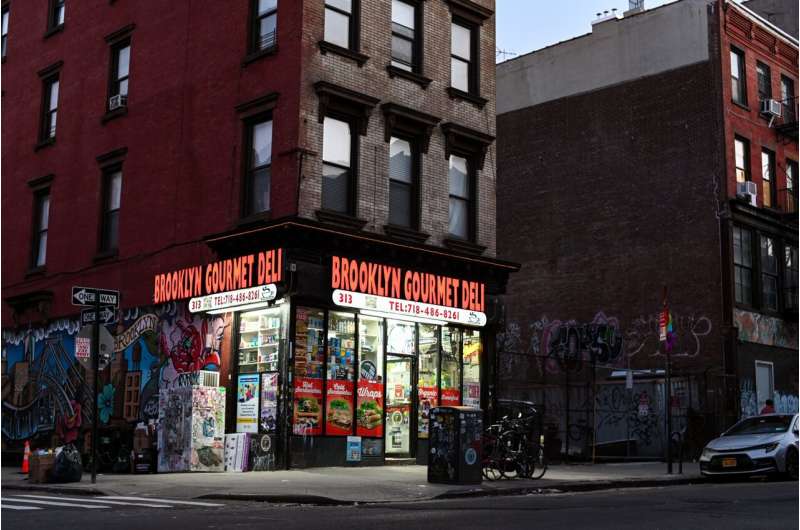Researchers gauge how predatory marketing targets vulnerable populations
A study by researchers at the CUNY Urban Food Policy Institute reveals a disproportionate presence of predatory food and beverage marketing in low-income New York City neighborhoods with negative health outcomes compared to wealthier neighborhoods.
For the study, lead author Katy Tomaino Fraser and colleagues conducted an outdoor environmental scan of the built environment to understand the presence and variations of predatory marketing in the South Bronx, Pelham Throggs Neck, the Upper West Side and Chelsea/Greenwich Village. Over a three-week period, pairs of trained researchers canvassed the neighborhoods to document the presence of food and beverage marketing using photographs taken on digital smart phone devices. The researchers focused on commercial areas in the vicinity of NYC Public Schools and NYC Housing Authority campuses with the highest and lowest nutrition related health indicators.
In their study published in Health & Place, the authors found predatory food and beverage ads to be concentrated around public schools and housing projects, and that bodegas and other food retailers such as fast food, supermarkets, restaurants, and liquor stores were responsible for posting the largest numbers of these ads. The authors recommend zoning laws that limit advertising in specific areas, such as within 1,000 feet of public schools or public housing developments, and policies to further restrict product displays and promotions at point of sale within food retail establishments.
“Our paper suggests that if you are a New Yorker living or working in a lower income neighborhood, you are exposed to almost twice the proportion of predatory food and beverage marketing messages compared to New Yorkers in higher income communities,” the authors say.
“Unless policies and programs that limit this disproportionate marketing of unhealthy foods and beverages to higher risk populations are put in place, there will continue to be barriers to closing the wide racial/ethnic and economic gaps in diet related diseases.”
Katherine Tomaino Fraser et al, Use of environmental scan to assess density, content, and variation of predatory food and beverage marketing in New York City, Health & Place (2022). DOI: 10.1016/j.healthplace.2022.102843
Citation:
Researchers gauge how predatory marketing targets vulnerable populations (2022, July 7)
retrieved 7 July 2022
from https://phys.org/news/2022-07-gauge-predatory-vulnerable-populations.html
This document is subject to copyright. Apart from any fair dealing for the purpose of private study or research, no
part may be reproduced without the written permission. The content is provided for information purposes only.

A study by researchers at the CUNY Urban Food Policy Institute reveals a disproportionate presence of predatory food and beverage marketing in low-income New York City neighborhoods with negative health outcomes compared to wealthier neighborhoods.
For the study, lead author Katy Tomaino Fraser and colleagues conducted an outdoor environmental scan of the built environment to understand the presence and variations of predatory marketing in the South Bronx, Pelham Throggs Neck, the Upper West Side and Chelsea/Greenwich Village. Over a three-week period, pairs of trained researchers canvassed the neighborhoods to document the presence of food and beverage marketing using photographs taken on digital smart phone devices. The researchers focused on commercial areas in the vicinity of NYC Public Schools and NYC Housing Authority campuses with the highest and lowest nutrition related health indicators.
In their study published in Health & Place, the authors found predatory food and beverage ads to be concentrated around public schools and housing projects, and that bodegas and other food retailers such as fast food, supermarkets, restaurants, and liquor stores were responsible for posting the largest numbers of these ads. The authors recommend zoning laws that limit advertising in specific areas, such as within 1,000 feet of public schools or public housing developments, and policies to further restrict product displays and promotions at point of sale within food retail establishments.
“Our paper suggests that if you are a New Yorker living or working in a lower income neighborhood, you are exposed to almost twice the proportion of predatory food and beverage marketing messages compared to New Yorkers in higher income communities,” the authors say.
“Unless policies and programs that limit this disproportionate marketing of unhealthy foods and beverages to higher risk populations are put in place, there will continue to be barriers to closing the wide racial/ethnic and economic gaps in diet related diseases.”
Katherine Tomaino Fraser et al, Use of environmental scan to assess density, content, and variation of predatory food and beverage marketing in New York City, Health & Place (2022). DOI: 10.1016/j.healthplace.2022.102843
Citation:
Researchers gauge how predatory marketing targets vulnerable populations (2022, July 7)
retrieved 7 July 2022
from https://phys.org/news/2022-07-gauge-predatory-vulnerable-populations.html
This document is subject to copyright. Apart from any fair dealing for the purpose of private study or research, no
part may be reproduced without the written permission. The content is provided for information purposes only.
